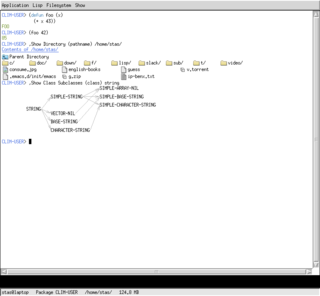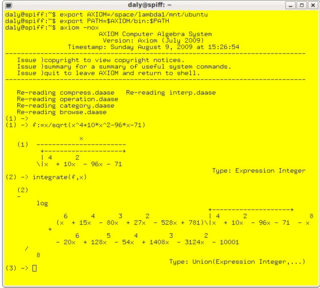Related Research Articles

Common Lisp (CL) is a dialect of the Lisp programming language, published in American National Standards Institute (ANSI) standard document ANSI INCITS 226-1994 (S2018). The Common Lisp HyperSpec, a hyperlinked HTML version, has been derived from the ANSI Common Lisp standard.
Hexadecimal is a positional numeral system that represents numbers using a radix (base) of sixteen. Unlike the decimal system representing numbers using ten symbols, hexadecimal uses sixteen distinct symbols, most often the symbols "0"–"9" to represent values 0 to 9 and "A"–"F" to represent values from ten to fifteen.

Lisp is a family of programming languages with a long history and a distinctive, fully parenthesized prefix notation. Originally specified in the late 1950s, it is the second-oldest high-level programming language still in common use, after Fortran. Lisp has changed since its early days, and many dialects have existed over its history. Today, the best-known general-purpose Lisp dialects are Common Lisp, Scheme, Racket, and Clojure.
In computer science, pseudocode is a description of the steps in an algorithm using a mix of conventions of programming languages with informal, usually self-explanatory, notation of actions and conditions. Although pseudocode shares features with regular programming languages, it is intended for human reading rather than machine control. Pseudocode typically omits details that are essential for machine implementation of the algorithm, meaning that pseudocode can only be verified by hand. The programming language is augmented with natural language description details, where convenient, or with compact mathematical notation. The purpose of using pseudocode is that it is easier for people to understand than conventional programming language code, and that it is an efficient and environment-independent description of the key principles of an algorithm. It is commonly used in textbooks and scientific publications to document algorithms and in planning of software and other algorithms.

Polish notation (PN), also known as normal Polish notation (NPN), Łukasiewicz notation, Warsaw notation, Polish prefix notation or simply prefix notation, is a mathematical notation in which operators precede their operands, in contrast to the more common infix notation, in which operators are placed between operands, as well as reverse Polish notation (RPN), in which operators follow their operands. It does not need any parentheses as long as each operator has a fixed number of operands. The description "Polish" refers to the nationality of logician Jan Łukasiewicz, who invented Polish notation in 1924.

Scheme is a dialect of the Lisp family of programming languages. Scheme was created during the 1970s at the MIT Computer Science and Artificial Intelligence Laboratory and released by its developers, Guy L. Steele and Gerald Jay Sussman, via a series of memos now known as the Lambda Papers. It was the first dialect of Lisp to choose lexical scope and the first to require implementations to perform tail-call optimization, giving stronger support for functional programming and associated techniques such as recursive algorithms. It was also one of the first programming languages to support first-class continuations. It had a significant influence on the effort that led to the development of Common Lisp.

In computer programming, an S-expression is an expression in a like-named notation for nested list (tree-structured) data. S-expressions were invented for and popularized by the programming language Lisp, which uses them for source code as well as data.

In mathematics and computer programming, the order of operations is a collection of rules that reflect conventions about which operations to perform first in order to evaluate a given mathematical expression.
Mathematical notation consists of using symbols for representing operations, unspecified numbers, relations, and any other mathematical objects and assembling them into expressions and formulas. Mathematical notation is widely used in mathematics, science, and engineering for representing complex concepts and properties in a concise, unambiguous, and accurate way.
In computer programming, M-expressions were an early proposed syntax for the Lisp programming language, inspired by contemporary languages such as Fortran and ALGOL. The notation was never implemented into the language and, as such, it was never finalized.
In computer science, primitive data types are a set of basic data types from which all other data types are constructed. Specifically it often refers to the limited set of data representations in use by a particular processor, which all compiled programs must use. Most processors support a similar set of primitive data types, although the specific representations vary. More generally, primitive data types may refer to the standard data types built into a programming language. Data types which are not primitive are referred to as derived or composite.

In mathematics, an expression is a written arrangement of symbols following the context-dependent, syntactic conventions of mathematical notation. Symbols can denote numbers, variables, operations, and functions. Other symbols include punctuation marks and brackets, used for grouping where there is not a well-defined order of operations.
Fortress is a discontinued experimental programming language for high-performance computing, created by Sun Microsystems with funding from DARPA's High Productivity Computing Systems project. One of the language designers was Guy L. Steele Jr., whose previous work includes Scheme, Common Lisp, and Java.
In computer programming, homoiconicity is an informal property of some programming languages. A language is homoiconic if a program written in it can be manipulated as data using the language. The program's internal representation can thus be inferred just by reading the program itself. This property is often summarized by saying that the language treats code as data. The informality of the property arises from the fact that, strictly, this applies to almost all programming languages. No consensus exists on a precise definition of the property.

The Common Lisp Interface Manager (CLIM) is a Common Lisp-based programming interface for creating user interfaces, i.e., graphical user interfaces (GUIs). It provides an application programming interface (API) to user interface facilities for the programming language Lisp. It is a fully object-oriented programming user interface management system, using the Common Lisp Object System (CLOS) and is based on the mechanism of stream input and output. There are also facilities for output device independence. It is descended from the GUI system Dynamic Windows of Symbolics' Lisp machines between 1988 and 1993.
... you can check out Common Lisp Interface Manager (CLIM). A descendant of the Symbolics Lisp machines GUI framework, CLIM is powerful but complex. Although many commercial Common Lisp implementations actually support it, it doesn't seem to have seen a lot of use. But in the past couple years, an open-source implementation of CLIM, McCLIM – now hosted at Common-Lisp.net – has been picking up steam lately, so we may be on the verge of a CLIM renaissance. – From Practical Common Lisp
The less-than sign is a mathematical symbol that denotes an inequality between two values. The widely adopted form of two equal-length strokes connecting in an acute angle at the left, <, has been found in documents dated as far back as the 1560s. In mathematical writing, the less-than sign is typically placed between two values being compared and signifies that the first number is less than the second number. Examples of typical usage include 1⁄2 < 1 and −2 < 0.

In mathematics and computer science, computer algebra, also called symbolic computation or algebraic computation, is a scientific area that refers to the study and development of algorithms and software for manipulating mathematical expressions and other mathematical objects. Although computer algebra could be considered a subfield of scientific computing, they are generally considered as distinct fields because scientific computing is usually based on numerical computation with approximate floating point numbers, while symbolic computation emphasizes exact computation with expressions containing variables that have no given value and are manipulated as symbols.

The Wolfram Language is a proprietary, general-purpose, very high-level multi-paradigm programming language developed by Wolfram Research. It emphasizes symbolic computation, functional programming, and rule-based programming and can employ arbitrary structures and data. It is the programming language of the mathematical symbolic computation program Mathematica.
In mathematics, a symbolic language is a language that uses characters or symbols to represent concepts, such as mathematical operations, expressions, and statements, and the entities or operands on which the operations are performed.
In engineering, a symbolic language is a language that uses standard symbols, marks, and abbreviations to represent concepts such as entities, aspects, attributes, and relationships.
References
- 1 2 "symbolic language Definition from PC Magazine Encyclopedia". www.pcmag.com. Retrieved 2019-03-23.
- ↑ "Bret Victor, beast of burden". worrydream.com. Retrieved 2019-03-23.
- ↑ "Symbolic Programming Visualized—Wolfram Blog". 13 May 2007. Retrieved 2019-03-23.